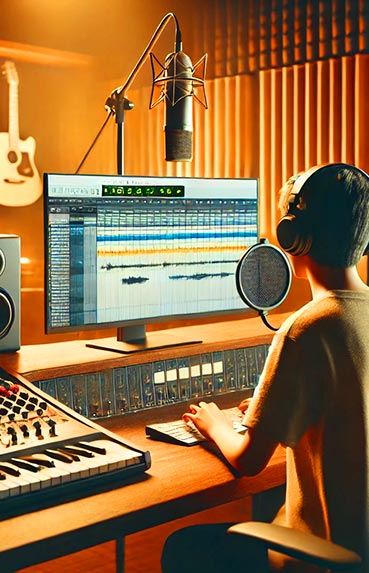Over the past decade, artificial intelligence (AI) has emerged as one of the most transformative forces across multiple industries, and graphic design is no exception. The ability of machines to learn, adapt, and, in some cases, create autonomously is redefining the concept of creativity in the design realm. This article explores how AI is revolutionizing graphic design, balancing human creativity with automation.
The Evolution of Graphic Design with AI
The Convergence of AI and Design
Graphic design has historically been a field dominated by human creativity. However, with the arrival of AI, graphic design is undergoing a radical transformation. Machine learning algorithms can now analyze and replicate design patterns, allowing designers to focus on more creative and strategic tasks.
Automation and Efficiency
Automation is one of the most notable benefits of AI in graphic design. Tools like Adobe Sensei use artificial intelligence to automate repetitive tasks, such as image tagging or color correction, saving designers time and effort.
- Error Reduction: AI algorithms can significantly reduce human errors in tasks like dimension adjustments and graphic element alignment.
- Increased Productivity: With the automation of tedious tasks, designers can concentrate on creativity and innovation.
AI Tools in Graphic Design
Adobe Sensei
Adobe Sensei is an artificial intelligence engine that powers various functions within the Adobe Creative Cloud suite. It uses AI to enhance the efficiency and precision of design tools.
- Automatic Retouching: Sensei allows for automatic image retouching, making it easier to remove imperfections and improve the visual quality of photos.
- Image Recognition: AI can automatically tag and organize images, streamlining the workflow.
Canva and AI
Canva, an online graphic design platform, has incorporated AI to improve design accessibility for non-specialist users.
- Design Suggestions: It uses AI to offer design suggestions based on user preferences and current trends.
- Task Automation: Allows for the quick creation of customized templates, making design accessible to those without prior experience.
Human Creativity Enhanced by AI
AI as a Creative Assistant
Far from replacing human creativity, AI can act as an assistant that enhances the designer's creative capacity.
- Idea Generation: AI algorithms can generate multiple variations of a design, providing the designer with new perspectives and options.
- Mass Personalization: AI enables the creation of personalized content for specific audiences, tailoring designs to individual preferences.
AI does not replace human creativity; it complements it, expanding its possibilities and horizons.
Examples of Augmented Creativity
There are several cases where AI has expanded the boundaries of creativity in graphic design:
- DeepArt: This application uses neural networks to transform photos into artworks imitating the style of famous artists.
- Runway ML: Provides AI tools for artists and designers seeking to integrate algorithms into their creative process, facilitating the creation of innovative visual effects.
Impact of AI on the Graphic Design Job Market
New Professional Opportunities
The integration of AI in graphic design has generated a demand for new skills and roles.
- User Experience (UX) Designers: Personalizing digital experiences through AI requires designers who understand how users interact with technology.
- Visual Data Analysts: The ability to interpret and apply data in design is becoming an essential skill.
Challenges and Adaptation
While AI offers many opportunities, it also presents challenges that design professionals must face.
- Skill Updating: Designers need to adapt to new tools and techniques, staying updated with technological trends.
- Ethics in Design: AI raises ethical questions, such as the use of personal data in personalized design and authorship of machine-generated works.
Practical Tips for Designers
Integrating AI into the Creative Process
To fully leverage the advantages of AI in graphic design, designers can follow these tips:
- Constant Experimentation: Explore and experiment with different AI tools to discover new creative possibilities.
- Collaboration with Technology: Consider AI as another collaborator in the design team, integrating its capabilities into the workflow.
Balancing Creativity and Technology
It's crucial to find a balance between the use of AI and human creativity.
- Fostering Human Innovation: Use AI to free up time and resources, allowing designers to focus on innovation and strategic thinking.
- Valuing Human Intuition and Judgment: While AI can offer valuable suggestions, the designer's intuition and judgment are irreplaceable.
The Future of Graphic Design with AI
Emerging Trends
The future of graphic design with AI promises to be exciting, with several emerging trends:
- Generative Design: Using algorithms to create unique and complex designs that would be impossible to achieve manually.
- Enhanced Interactivity: AI will enable more interactive and personalized user experiences, adapting in real-time to user needs.
Long-term Impact
As AI continues to evolve, its long-term impact on graphic design will be significant.
- Revolution in Design Education: Educational programs will need to adapt to include training in AI and data analysis.
- Redefinition of the Designer's Role: Designers will need to evolve to become mediators between human creativity and advanced technology.
Artificial intelligence is transforming graphic design in unprecedented ways, combining human creativity with the power of automation. As this technology continues to advance, designers have the opportunity to harness its capabilities to innovate and create impactful visual experiences.

















